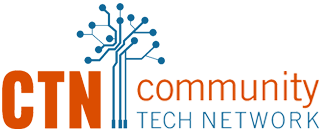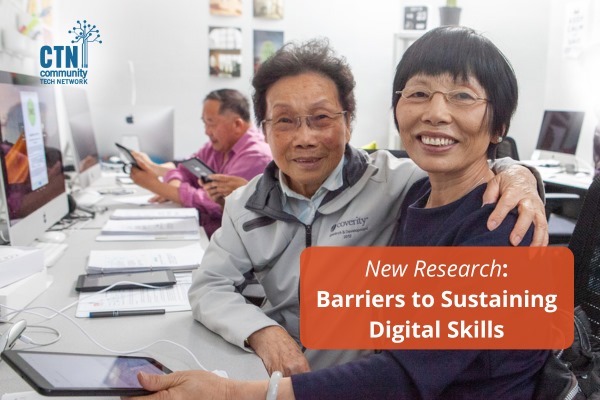The COVID-19 pandemic made it impossible to ignore the digital divide, underscoring the challenges faced by older adults who are offline. While access to technology and initial digital skills training are crucial first steps in promoting digital equity, several key questions arise. How can older adults sustain their newfound digital literacy? What barriers do they face in the process?
This blog post delves into research investigating these inquiries. The research was conducted by CTN’s Hyewon Park, who holds a Ph.D. in Lifelong Learning and Adult Education from Pennsylvania State University. You can read Hyewon’s full research report here (PDF).
Background
Since 2008, CTN has provided in-person digital skills training and tutoring at public libraries, low-income housing developments, senior centers, schools, and social service agencies across California. However, when public computer labs closed in response to the COVID-19 pandemic, many older adults were stranded at home without access to shared computers and the internet.
In response to the pressing need for devices, internet access, and digital skills training for these homebound older adults, CTN initiated the Home Connect program in March 2020. This personalized, one-on-one virtual learning program, available in eight languages, successfully engaged more than 982 individuals aged 60 and above in San Francisco in their own homes.
The program, which continues today, provides both initial digital literacy training and ongoing support through virtual Q&A sessions in order to ensure sustained learning and skill development.
Digital Literacy Skill Utilization
CTN was curious about whether the learners who participated in the Home Connect program could eliminate some of the barriers to internet use and adoption. The research conducted by Hyewon Park analyzes the digital literacy skill utilization patterns among Home Connect learners. It reveals four distinct usage patterns: growing, initially growing but not sustaining, nonchanging, and decreasing. More than 63% of learners showed a growing pattern — largely in part due to CTN’s ongoing Q&A sessions, which allow folks to continue their digital skills education beyond their initial classes. However, challenges in sustaining and enhancing skills were still evident in other learners. Some of the principal barriers that they faced are outlined below.
Barriers to Sustaining Digital Literacy Skills
Park’s research explores the barriers faced by older adult learners in maintaining their digital literacy skills:
- Physical Challenges: Memory issues emerged as a significant hurdle for learners, impacting their ability to retain and apply digital skills. Says one learner, “I don’t even remember how to turn on/off my device. I always ask my son for help.”
- Technical Troubles: Learners faced frustration with consistent technical issues, such as disappearing buttons and unstable Wi-Fi connections.
- Rapidly Changing Systems: Keeping up with system updates and changing interfaces proved challenging for older adults, leading to confusion and functional issues.
- Lack of Ongoing Support: The perceived absence of ongoing technical assistance hindered learners from exploring new functions and addressing challenges independently. CTN attempts to counter this with its Q&A sessions, which seem to make a difference. According to one learner, “I try to troubleshoot the problems myself first, Google about it. If I cannot find a solution by myself, I ask CTN during Q&A, or go to the community center to ask the volunteers, or staff at the library.”
Conclusion
The research concludes by emphasizing the need for a comprehensive approach to address the challenges faced by older adults in the digital age. It highlights the importance of consistent support, relevant resources, and opportunities for connection and continuous learning. CTN’s virtual Q&A sessions are presented as an exemplary model, fostering a learning community that helps older adults overcome barriers, connect with others, and consistently improve their digital literacy skills.
In summary, bridging the digital divide requires not only initial infrastructure and training but also ongoing support and resources to empower older adults in the digital age. CTN’s Home Connect program stands as a model, demonstrating the efficacy of personalized, sustained efforts in enhancing and maintaining digital literacy skills for older adults.


Comments are closed.